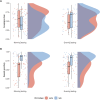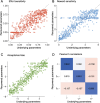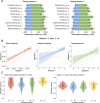A common alteration in effort-based decision-making in apathy, anhedonia, and late circadian rhythm
- PMID: 40522113
- PMCID: PMC12169849
- DOI: 10.7554/eLife.96803
A common alteration in effort-based decision-making in apathy, anhedonia, and late circadian rhythm
Abstract
Motivational deficits are common in several brain disorders, and motivational syndromes like apathy and anhedonia predict worse outcomes. Disrupted effort-based decision-making may represent a neurobiological underpinning of motivational deficits, shared across neuropsychiatric disorders. We measured effort-based decision-making in 994 participants using a gamified online task, combined with computational modelling, and validated offline for test-retest reliability. In two pre-registered studies, we first replicated studies linking impaired effort-based decision-making to neuropsychiatric syndromes, taking both a transdiagnostic and a diagnostic-criteria approach. Next, testing participants with early and late circadian rhythms in the morning and evening, we find circadian rhythm interacts with time-of-testing to produce parallel effects on effort-based decision-making. Circadian rhythm may be an important variable in computational psychiatry, decreasing reliability or distorting results when left unaccounted for. Disentangling effects of neuropsychiatric syndromes and circadian rhythm on effort-based decision-making will be essential to understand motivational pathologies and to develop tailored clinical interventions.
Keywords: circadian rhythm; computational biology; computational psychiatry; effort-based decision-making; human; motivational syndromes; neuroscience; systems biology.
Plain language summary
Our bodies are regulated by an internal circadian clock that aligns physiological processes to a 24-hour day-to-night cycle. However, the timing of this rhythm can vary: some people are ‘early birds’ who prefer mornings, while others are ‘night owls’ who prefer to wake up and stay up late. Circadian rhythms have been closely linked to neuropsychiatric conditions like depression, as well as specific psychiatric symptoms such as reduced motivation. Despite this, the circadian clock is seldom considered when investigating the cognitive and motivational changes associated with mental health conditions. To address this gap, Mehrhof and Nord designed a study to assess motivational differences in the general population and examine whether there were associations between neuropsychiatric symptoms and circadian rhythms. The study focused on effort-based decisions – where individuals choose whether completing a task is worth the effort of the reward – as disruptions in this process often underpin motivational deficits in neuropsychiatric disorders. Mehrhof and Nord found that individuals with high neuropsychiatric symptoms were less likely to undertake effort-based tasks, consistent with previous studies. Night owls showed the same motivational deficit – even when taking into account neuropsychiatric differences. However, this loss of motivation only occurred when the night owls were tested in the morning. When tested in the evening, their performance matched that of individuals who had an earlier circadian rhythm. These findings suggest that the circadian clock and neuropsychiatric conditions affect motivation in independent but parallel manners. In addition, testing someone at times of day that misalign with their circadian rhythm may be skewing the results of psychiatric studies. Further research could explore whether aligning treatment schedules and daily routines to a person’s internal clock improves motivation and other mental health outcomes.
© 2024, Mehrhof and Nord.
Conflict of interest statement
SM, CN No competing interests declared
Figures









Update of
- doi: 10.31234/osf.io/z69w4
- doi: 10.7554/eLife.96803.1
- doi: 10.7554/eLife.96803.2
- doi: 10.7554/eLife.96803.3
Similar articles
-
Computational Phenotyping of Effort-Based Decision Making in Unmedicated Adults With Remitted Depression.Biol Psychiatry Cogn Neurosci Neuroimaging. 2025 Jun;10(6):607-615. doi: 10.1016/j.bpsc.2025.02.006. Epub 2025 Feb 24. Biol Psychiatry Cogn Neurosci Neuroimaging. 2025. PMID: 40010688
-
Assessing the comparative effects of interventions in COPD: a tutorial on network meta-analysis for clinicians.Respir Res. 2024 Dec 21;25(1):438. doi: 10.1186/s12931-024-03056-x. Respir Res. 2024. PMID: 39709425 Free PMC article. Review.
-
Molecular feature-based classification of retroperitoneal liposarcoma: a prospective cohort study.Elife. 2025 May 23;14:RP100887. doi: 10.7554/eLife.100887. Elife. 2025. PMID: 40407808 Free PMC article.
-
Mood Status Response to Physical Activity and Its Influence on Performance: Are Chronotype and Exercise Timing Affect?Int J Environ Res Public Health. 2023 Feb 5;20(4):2822. doi: 10.3390/ijerph20042822. Int J Environ Res Public Health. 2023. PMID: 36833520 Free PMC article.
-
Preferences on Treatment Decision Making in Sarcoma Patients: Prevalence and Associated Factors - Results from the PROSa Study.Oncol Res Treat. 2025;48(4):174-185. doi: 10.1159/000543456. Epub 2025 Jan 15. Oncol Res Treat. 2025. PMID: 39814000
References
MeSH terms
Grants and funding
LinkOut - more resources
Full Text Sources
Miscellaneous

